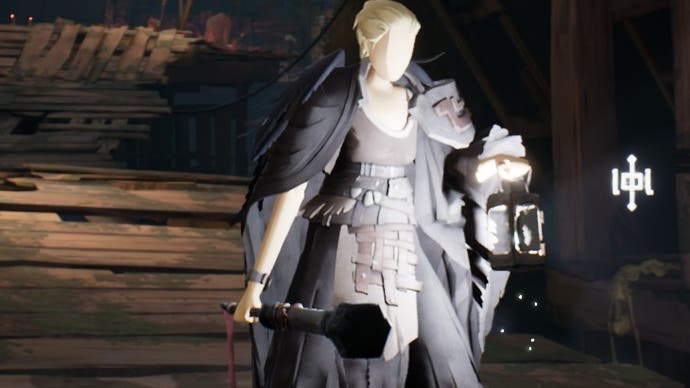Ashen review - a soulful journey through a sublime ruined world
The white stuff.
Ashen is about exploring and cleansing a newly radiant world, but it's often at its best in the dark. A few hours into this derivative but engrossing third-person RPG, there's a quest that takes you deep below ground in search of a corrupted giantess queen. Entering her realm is an ordeal - the nearby hills are alive with other giants who are fond of leaping on your head, to say nothing of coyote-type predators that breath fire - but the catacombs themselves are something else.
The surface world's packs of club-wielding vagrants give way, here, to more treacherous breeds of foe. Skeletons who lunge from their dust as you pass (in a masterful bit of risk-reward design, you can shatter them with one blow if you catch them mid-resurrection), and wraiths who evaporate on contact only to pounce from the blackness. Wall-crawlers with peeled-open chests who lurk below ledges, popping up behind you with an easily-missed slither of flesh. All these violent delights plus yet more giants, silhouetted near corridor mouths or looming in the stark but short-ranged glare of your lantern - unhelpfully, given the perils of dodging with deadfalls to either side, you can't hold the latter and a shield at the same time. It took me a couple hours to bumble through that wondrous nightmare to the cavern at the area's base, where the abundance of space felt positively decadent. It's probably the finest dungeon environment I've set foot in this year.
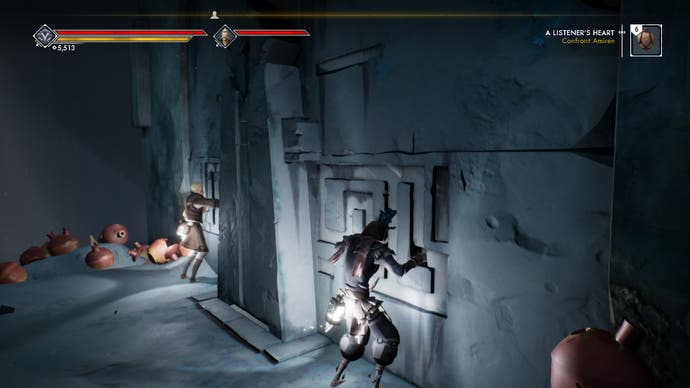
For all that, Ashen is also often at its best in the light. There's another area later on that is much less clever but similarly oppressive, not least for its population of spear-chucking cultists. Survive it and you're treated to a glorious vista of a fallen city, inspired (to my untrained eye) by Mughal architecture - bronze domes catching the daybreak above pastel pink cobbles and demolished houses. The nature and timing of this spectacle immediately recall Anor Londo, the heavenly city of Dark Souls, much as the queen's realm feels like a mishmash of the latter's Catacombs and Tomb of the Giants. Ashen owes an awful lot to From Software's work - to pick out the most obvious mechanical debts, all your XP is dropped in a puddle on death, and landscapes are woven around runestones where you can meditate cross-legged to refill your healing gourd, at the price of reviving all the enemies you've slain. It's essentially a cleaned-up cover version, though its art direction and scanty multiplayer elements have more in common with Journey. But if it never really surprises, and lacks the scale and elusiveness of its inspirations, Ashen is elegant and demanding enough to stand on its own feet.
The eponymous Ashen is a massive bird whose luminous plumage supplies the game's world with a sun. As the story begins the creature has been dead for many years, its skull lolling over the horizon like a crashed starship, but its resurrection is at hand. Your task is to purge the various evils who have festered over decades of night, from malicious spirits underground to the bandit tribes and giants who roam the wastes. In the process you'll also found a settlement, as characters you meet return to the starting area and build dwellings, smithies and breweries while you're off clobbering nasties. If the function of the village is to let you tweak and upgrade your equipment while unlocking sidequests that further expand your crafting options, the pleasure of it is watching the community grow. In the course of 20 hours or so, patches of broken stone give way to floorboards and tapestries, scaffolds to peaked roofs, and the soundscape fills with the clatter and murmur of everyday existence.
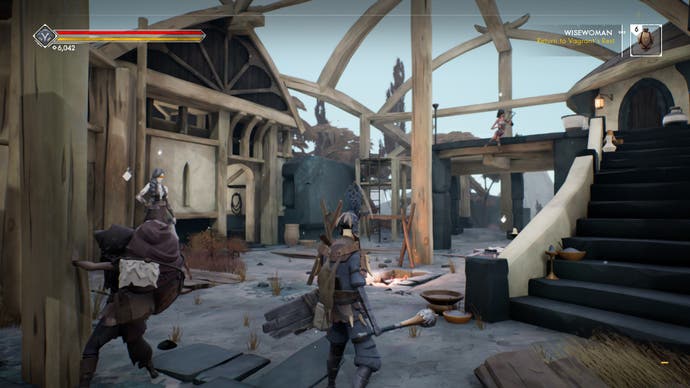
It's a lovely creation, that village, a diorama evolving in stop-motion, and the landscapes beyond are no less ravishing. There are citadels engulfed in soot, canyons choked with rope bridges and a battered coastal fortress with a frost-breathing behemoth perched atop it. The layouts follow the broad Souls principle of long stretches of claustrophobia followed by breathless, dazzling openness, and the game is fond, too, of showing you how far you've travelled, with certain landmarks visible almost everywhere in the world. It is, however, relatively linear of structure, a wide S-shaped corridor chopped up into regions with their own distinct ambience and hazards. Sometimes the critical path shoots out a limb - an initially forbidding cave near your village, for example, where you'll prise rare resources from the claws of wraiths - and there's some doubling-back to do once you acquire a certain ability. But there's seldom that quintessentially Soulsy elation when you realise a sidepath actually links back to a familiar location, and in any case, there are waypoints and a map to help you navigate. It's closer to Journey - an influence also tangible in the glee of sliding down sand dunes - in that as dizzying as your surroundings may appear, you're seldom in doubt about where to go.
Similar things can be said about the stripped-down combat and character development. There are no character stats to manage save for health and stamina, which are raised by completing specific quests and finding certain items. Weapons can be upgraded ad nauseam, but there's no scaling of weapon strength by character stat, and no myriad of elemental strengths or impact types - just the choice of damage dealt, stagger potential and chance of a critical hit. You can equip two at once, a one-handed weapon for quick attacks and a two-hander for skull-splitting finishers, plus a shield and throwing spears. It's the Souls progression path boiled back to the marrow, and while I'd have appreciated a wider range of character builds, Ashen's relative shortness means you don't really have time to get bored. For those in search of more flavour, Talismans and Relics serve as eccentric character modifiers. One causes wings to grow from your back, increasing your XP gain per kill till the wings are fully grown, whereupon they'll reflect a portion of damage back at your attacker. Others let you hit harder when you strike from behind, or increase your health the further you travel from the village.
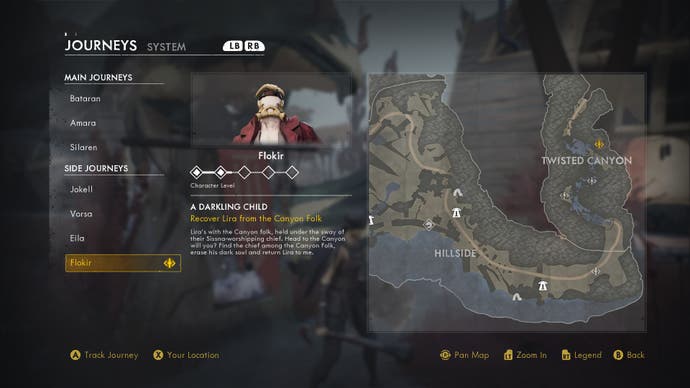
Combat itself hinges on managing your stamina: you'll need plenty of juice to dodge, block and swing, and running out often leads to a sticky end. The animations are elegant if a touch robotic, and there are plenty of visual and audible cues to help you read the flow of each duel. Beyond the basics of probing for gaps in animation patterns, victory is about memorising each enemy's spawn location and the proximity at which you'll rile it. Initially, you'll stumble from one ambush to the next, galloping towards a lone vagrant by a campfire only to discover that there are three more in the underbrush. Gradually, you'll learn the value of caution and deviousness, baiting the elites away from or into chokepoints with thrown spears, and spinning the camera as you approach each corner to peek behind it.
That's when your allies permit this, anyway. Ashen is a lot easier than it perhaps should be because you're always accompanied by one of your villagers, each armed with their own gear, healing gourd and the ability to revive you. While slightly prone to strolling into pits, the AI is very capable in a brawl; it also knows each area's layout in advance, zipping along paths you can't even see to steamroll enemies you've barely noticed. The result is that you're occasionally denied the chance to really put the combat mechanics through their paces. The AI does generally let you make the first move, but I've won too many fights by kicking the wasp's nest and putting up token resistance while the computer channels its inner Legolas.
You can, in fairness, find a Relic that lets you wander alone, and there's an additional twist: your ally may in fact be another player, slyly introduced via background matchmaking. I wasn't able to infiltrate anybody's game or be infiltrated in turn during my playthrough, but then again, there don't seem to be any explicit signs that other players are present. For all I know I've had human company throughout. It lends a certain existential undercurrent to the game's character design, with faces left eerily featureless save for the odd touch of beard, as though everybody had evolved to live without eyes and mouths over the centuries of darkness. The game takes its cue again from Journey here, but in lumbering you with an ally throughout, it spoils the latter's sense of mystery. Part of the reason Journey's multiplayer encounters are so strange and compelling, after all, is that you aren't paired with anybody by default.
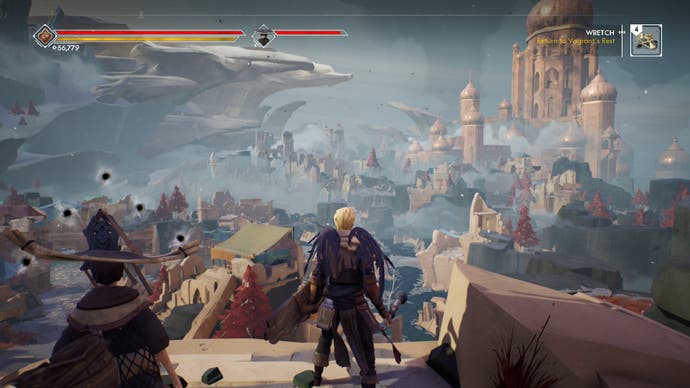
Mystery, I think, is Ashen's missing link. The concept of a realm recently lifted from apocalypse is majestically played out in the environments, but undercut by dialogue, quest and item descriptions that want to explain rather than tantalise. The writing has colour (and an exciting range of accents) but the delivery is generic - this is one of those fantasy RPGs where every weapon comes with a quote from a cast member, like “this axe chops stuff real good”. In general, Ashen is so in love with the enigmatic workings of From and Thatgamecompany's creations that it neglects to kindle enigmas of its own. Still, it's a robust and often mesmerising piece of craftsmanship that serves as a gentle introduction to the Souls subgenre, though it's definitely no substitute for Journey. And for a veteran of Lordran, there's genuine satisfaction to unravelling its reinventions and departures - identifying the places where it sheds a little more light on Souls at large, and the places where it lets the darkness close in.
